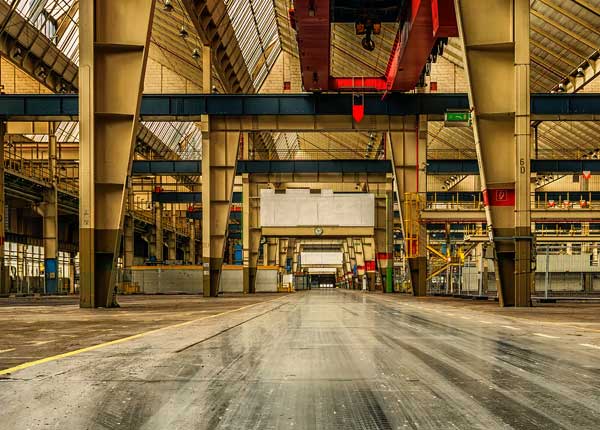Strengths Of The Ohio County, Kentucky Labor Market
Ohio County’s location gives access to a population of nearly 400,000+ people and nearly 200,000 workers. Our tremendous location between two major intersecting highways plus available rail infrastructure allows for an easy commute between Owensboro and Bowling Green. With access to our extensive workforce, along with our infrastructure advantages, it is no wonder we have more than the national average in so many occupations!
Our Location Advantage
- Easy access to I-69 & I-165
- 2 Times the Manufacturing Labor Compared to the National Average
- 15 times the national average of people employed as Pourers and Casters, Metal
- 8 times the national average of people employed as Metal-Refining Furnace Operators and Tenders
- 4 times the national average of people employed as Welders

Tremendous Interstate Infrastructure & Access to Talent
Ohio County’s location gives us access to a highly technical workforce. Our location and interstate access provide us with high concentration of skilled workers that can’t be beat as you will see below.

Workforce Study
Just Look at Our Labor Regions’ Comparison to the National Average!
Just Look at Our Labor Regions’ Comparison to the National Average!
- 15 times the national average of people employed as Pourers and Casters, Metal
- 8 times the national average of people employed as Metal-Refining Furnace Operators and Tenders
- 7 times the national average of people employed as Gas Plant Operators
- 7 times the national average of people employed as Roof Bolters, Mining
- 5 times the national average of people employed as Forging Machine Setters, Operators, and Tenders, Metal and Plastic
- 5 times the national average of people employed as Loading and Moving Machine Operators, Underground Mining
- 5 times the national average of people employed as Extruding and Drawing Machine Setters, Operators, and Tenders, Metal and Plastic
- 5 times the national average of people employed as Cutting, Punching, and Press Machine Setters, Operators, and Tenders, Metal and Plastic
- 4 times the national average of people employed as Welding, Soldering, and Brazing Machine Setters, Operators, and Tenders
- 4 times the national average of people employed as Milling and Planing Machine Setters, Operators, and Tenders, Metal and Plastic
- 4 times the national average of people employed as Tool and Die Makers
- 4 times the national average of people employed as Furnace, Kiln, Oven, Drier, and Kettle Operators and Tenders
- 3 times the national average of people employed as Rolling Machine Setters, Operators, and Tenders, Metal and Plastic
- 3 times the national average of people employed as Slaughterers and Meat Packers
- 3 times the national average of people employed as Paper Goods Machine Setters, Operators, and Tenders
- 3 times the national average of people employed as Molding, Coremaking, and Casting Machine Setters, Operators, and Tenders, Metal and Plastic
- 3 times the national average of people employed as Patternmakers, Metal and Plastic
- 3 times the national average of people employed as Continuous Mining Machine Operators
- 3 times the national average of people employed as Millwrights
- 3 times the national average of people employed as Adhesive Bonding Machine Operators and Tenders
- 3 times the national average of people employed as Cleaning, Washing, and Metal Pickling Equipment Operators and Tenders
- 3 times the national average of people employed as Sawing Machine Setters, Operators, and Tenders, Wood
- 3 times the national average of people employed as Foundry Mold and Coremakers
- 3 times the national average of people employed as Rock Splitters, Quarry
- 3 times the national average of people employed as Food Processing Workers, All Other
- 3 times the national average of people employed as Chemical Equipment Operators and Tenders
- 3 times the national average of people employed as ndustrial Machinery Mechanics
- 3 times the national average of people employed as Maintenance Workers, Machinery
- 2 times the national average of people employed as Farm Equipment Mechanics and Service Technicians
- 2 times the national average of people employed as Woodworking Machine Setters, Operators, and Tenders, Except Sawing
- 2 times the national average of people employed as Packaging and Filling Machine Operators and Tenders
- 2 times the national average of people employed as Multiple Machine Tool Setters, Operators, and Tenders, Metal and Plastic
- 2 times the national average of people employed as Team Assemblers
- 2 times the national average of people employed as Meat, Poultry, and Fish Cutters and Trimmers
- 2 times the national average of people employed as Plant and System Operators, All Other
- 2 times the national average of people employed as Cutting and Slicing Machine Setters, Operators, and Tenders
- 2 times the national average of people employed as Tool Grinders, Filers, and Sharpeners
- 2 times the national average of people employed as Extruding, Forming, Pressing, and Compacting Machine Setters, Operators, and Tenders
- 2 times the national average of people employed as Helpers--Production Workers
- 2 times the national average of people employed as First-Line Supervisors of Production and Operating Workers
- 2 times the national average of people employed as Heat Treating Equipment Setters, Operators, and Tenders, Metal and Plastic
- 2 times the national average of people employed as Plating Machine Setters, Operators, and Tenders, Metal and Plastic
- 2 times the national average of people employed as Food Cooking Machine Operators and Tenders
- 2 times the national average of people employed as Cooling and Freezing Equipment Operators and Tenders
- 2 times the national average of people employed as Power Distributors and Dispatchers
- 2 times the national average of people employed as Engine and Other Machine Assemblers
- 2 times the national average of people employed as Underground Mining Machine Operators and Extraction Workers, All Other
- 2 times the national average of people employed as Power Plant Operators
- 2 times the national average of people employed as Crushing, Grinding, and Polishing Machine Setters, Operators, and Tenders
- 2 times the national average of people employed as Excavating and Loading Machine and Dragline Operators, Surface Mining
- 2 times the national average of people employed as Lathe and Turning Machine Tool Setters, Operators, and Tenders, Metal and Plastic
- 2 times the national average of people employed as Inspectors, Testers, Sorters, Samplers, and Weighers
- 2 times the national average of people employed as Mixing and Blending Machine Setters, Operators, and Tenders
- 2 times the national average of people employed as Conveyor Operators and Tenders
- 2 times the national average of people employed as Metal Workers and Plastic Workers, All Other
- 2 times the national average of people employed as Separating, Filtering, Clarifying, Precipitating, and Still Machine Setters, Operators, and Tenders
- 2 times the national average of people employed as Coating, Painting, and Spraying Machine Setters, Operators, and Tenders
- 2 times the national average of people employed as Assemblers and Fabricators, All Other
- 2 times the national average of people employed as Grinding, Lapping, Polishing, and Buffing Machine Tool Setters, Operators, and Tenders, Metal and Plastic
- 2 times the national average of people employed as Food and Tobacco Roasting, Baking, and Drying Machine Operators and Tenders
- 2 times the national average of people employed as Materials Engineers
- 2 times the national average of people employed as Industrial Engineering Technologists and Technicians
- 2 times the national average of people employed as Water and Wastewater Treatment Plant and System Operators
- 2 times the national average of people employed as Chemical Plant and System Operators
- 2 times the national average of people employed as Cutters and Trimmers, Hand
- 2 times the national average of people employed as Computer Numerically Controlled Tool Programmers
- 2 times the national average of people employed as Industrial Engineers
Our Industrial Labor Growth Over the Past 5 Years
- 64% growth in Textile Knitting and Weaving Machine Setters, Operators, and Tenders
- 50% growth in Textile Winding, Twisting, and Drawing Out Machine Setters, Operators, and Tenders
- 36% growth in Aircraft Cargo Handling Supervisors
- 27% growth in Separating, Filtering, Clarifying, Precipitating, and Still Machine Setters, Operators, and Tenders
- 26% growth in Multiple Machine Tool Setters, Operators, and Tenders, Metal and Plastic
- 25% growth in Plating Machine Setters, Operators, and Tenders, Metal and Plastic
- 23% growth in Rock Splitters, Quarry
- 23% growth in Extruding and Forming Machine Setters, Operators, and Tenders, Synthetic and Glass Fibers
- 21% growth in Computer Numerically Controlled Tool Programmers
- 20% growth in Aerospace Engineering and Operations Technologists and Technicians
- 18% growth in Industrial Engineers
- 17% growth in Rolling Machine Setters, Operators, and Tenders, Metal and Plastic
- 15% growth in Chemical Equipment Operators and Tenders
- 13% growth in Engine and Other Machine Assemblers
- 12% growth in Mechanical Engineers
- 10% growth in Food Batchmakers
- 8% growth in Electrical, Electronic, and Electromechanical Assemblers, Except Coil Winders, Tapers, and Finishers
- 8% growth in Computer Numerically Controlled Tool Operators
- 8% growth in Team Assemblers
- 8% growth in Inspectors, Testers, Sorters, Samplers, and Weighers
- 8% growth in Mechanical Engineering Technologists and Technicians
- 8% growth in Light Truck Drivers
- 8% growth in Gas Plant Operators
- 7% growth in Industrial Machinery Mechanics
- 7% growth in Paper Goods Machine Setters, Operators, and Tenders
- 7% growth in Materials Engineers
- 7% growth in Textile Cutting Machine Setters, Operators, and Tenders
- 6% growth in Heating, Air Conditioning, and Refrigeration Mechanics and Installers
- 6% growth in Aircraft Structure, Surfaces, Rigging, and Systems Assemblers
- 6% growth in Laborers and Freight, Stock, and Material Movers, Hand
- 6% growth in Plant and System Operators, All Other
- 5% growth in Coating, Painting, and Spraying Machine Setters, Operators, and Tenders
- 5% growth in Stockers and Order Fillers
Surplus of Manufacturing Labor
Our region has a notable strength in our quantity of production and support labor. Here is a sampling of production and support occupations with at least 500+ employed.
- 4,261 employed as Laborers and Freight, Stock, and Material Movers, Hand
- 3,093 employed as Stockers and Order Fillers
- 2,851 employed as Team Assemblers
- 2,676 employed as Heavy and Tractor-Trailer Truck Drivers
- 1,965 employed as Maintenance Workers
- 1,713 employed as Construction Laborers
- 1,466 employed as First-Line Supervisors of Production and Operating Workers
- 1,227 employed as Inspectors, Testers, Sorters, Samplers, and Weighers
- 1,165 employed as Industrial Machinery Mechanics
- 1,079 employed as Industrial Truck and Tractor Operators
- 1,077 employed as Light Truck Drivers
- 1,061 employed as Packaging and Filling Machine Operators and Tenders
- 1,010 employed as Electricians
- 992 employed as Cutting, Punching, and Press Machine Setters, Operators, and Tenders, Metal and Plastic
- 980 employed as Packers and Packagers, Hand
- 694 employed as Welders, Cutters, Solderers, and Brazers
- 594 employed as Helpers--Production Workers
- 581 employed as Machinists
- 567 employed as Molding, Coremaking, and Casting Machine Setters, Operators, and Tenders, Metal and Plastic
- 564 employed as First-Line Supervisors of Transportation and Material Moving Workers
- 532 employed as Industrial Engineers







